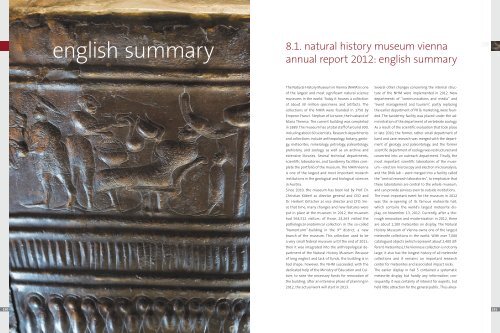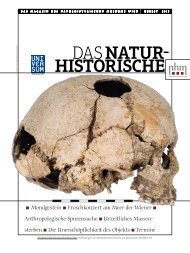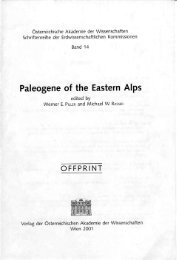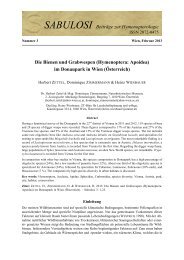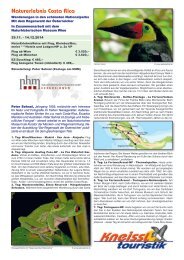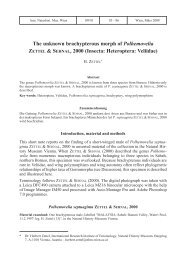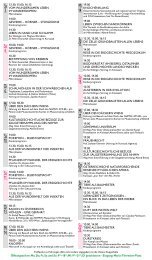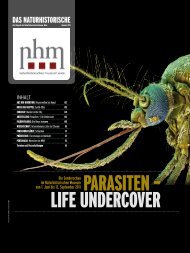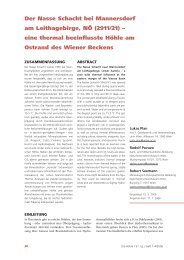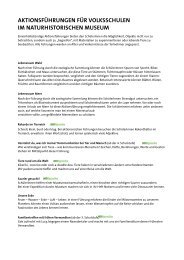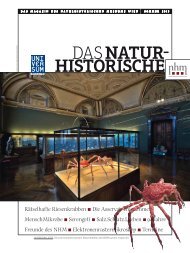jahresbericht 2012 - Naturhistorisches Museum Wien
jahresbericht 2012 - Naturhistorisches Museum Wien
jahresbericht 2012 - Naturhistorisches Museum Wien
Erfolgreiche ePaper selbst erstellen
Machen Sie aus Ihren PDF Publikationen ein blätterbares Flipbook mit unserer einzigartigen Google optimierten e-Paper Software.
english summary<br />
8.1. natural history museum vienna <br />
annual report <strong>2012</strong>: english summary<br />
08<br />
The Natural History <strong>Museum</strong> in Vienna (NHM) is one<br />
of the largest and most significant natural science<br />
museums in the world. Today it houses a collection<br />
of about 30 million specimens and artifacts. The<br />
collections of the NHM were founded in 1750 by<br />
Emperor Franz I. Stephan of Lorraine, the husband of<br />
Maria Theresa. The current building was completed<br />
in 1889. The museum has a total staff of around 300,<br />
including about 60 scientists. Research departments<br />
and collections include anthropology, botany, geology,<br />
meteorites, mineralogy, petrology, paleontology,<br />
prehistory, and zoology, as well as an archive and<br />
extensive libraries. Several technical departments,<br />
scientific laboratories, and taxidermy facilities complete<br />
the portfolio of the museum. The NHM Vienna<br />
is one of the largest and most important research<br />
institutions in the geological and biological sciences<br />
in Austria.<br />
Since 2010, the museum has been led by Prof. Dr.<br />
Christian Köberl as director general and CEO and<br />
Dr. Herbert Kritscher as vice director and CFO. Since<br />
that time, many changes and new features were<br />
put in place at the museum. In <strong>2012</strong>, the museum<br />
had 564,512 visitors; of those, 24,263 visited the<br />
pathological-anatomical collection in the so-called<br />
“Narrenturm”-building in the 9 th district, a new<br />
branch of the museum. This collection used to be<br />
a very small federal museum until the end of 2011;<br />
then it was integrated into the anthropological department<br />
of the Natural History <strong>Museum</strong>. Because<br />
of long neglect and lack of funds, the building is in<br />
bad shape; however, the NHM succeeded, with the<br />
dedicated help of the Ministry of Education and Culture,<br />
to raise the necessary funds for renovation of<br />
the building; after an intensive phase of planning in<br />
<strong>2012</strong>, the actual work will start in 2013.<br />
Several other changes concerning the internal structure<br />
of the NHM were implemented in <strong>2012</strong>. New<br />
departments of “communications and media” and<br />
“event management and tourism”, partly replacing<br />
the earlier department of PR & marketing, were founded.<br />
The taxidermy facility was placed under the administration<br />
of the department of vertebrate zoology.<br />
As a result of the scientific evaluation that took place<br />
in late 2010, the former, rather small department of<br />
karst and cave research was merged with the department<br />
of geology and paleontology, and the former<br />
scientific department of ecology was restructured and<br />
converted into an outreach department. Finally, the<br />
most important scientific laboratories of the museum<br />
– electron microscopy and electron microanalysis,<br />
and the DNA lab – were merged into a facility called<br />
the “central research laboratories”, to emphasize that<br />
these laboratories are central to the whole museum,<br />
and can provide services even to outside institutions.<br />
The most important event for the museum in <strong>2012</strong><br />
was the re-opening of its famous meteorite hall,<br />
which contains the world‘s largest meteorite display,<br />
on November 13, <strong>2012</strong>. Currently, after a thorough<br />
renovation and modernization in <strong>2012</strong>, there<br />
are about 1,100 meteorites on display. The Natural<br />
History <strong>Museum</strong> of Vienna owns one of the largest<br />
meteorite collections in the world. With over 7,000<br />
catalogued objects (which represent about 2,400 different<br />
meteorites), the Viennese collection is not only<br />
large; it also has the longest history of all meteorite<br />
collections and it remains an important research<br />
center for meteorites and associated impact rocks.<br />
The earlier display in hall 5 contained a systematic<br />
meteorite display but hardly any information; consequently,<br />
it was certainly of interest for experts, but<br />
held little attraction for the general public. Thus alrea-<br />
190<br />
<strong>jahresbericht</strong> <strong>2012</strong> | naturhistorisches museum wien<br />
191


